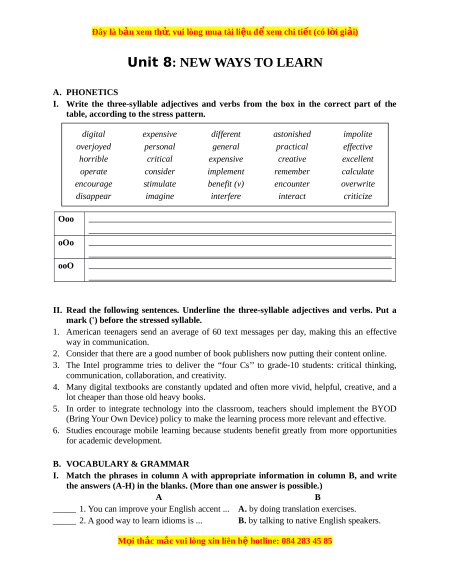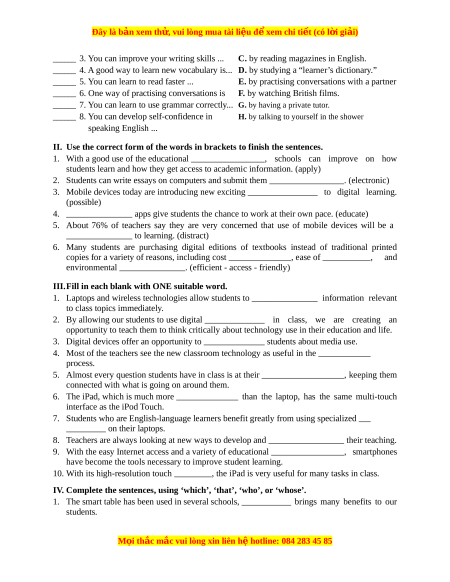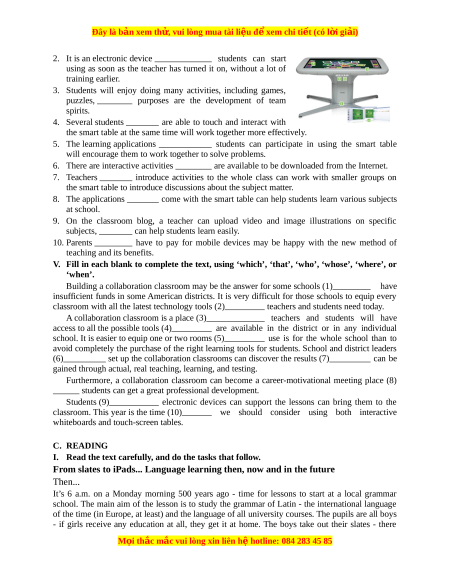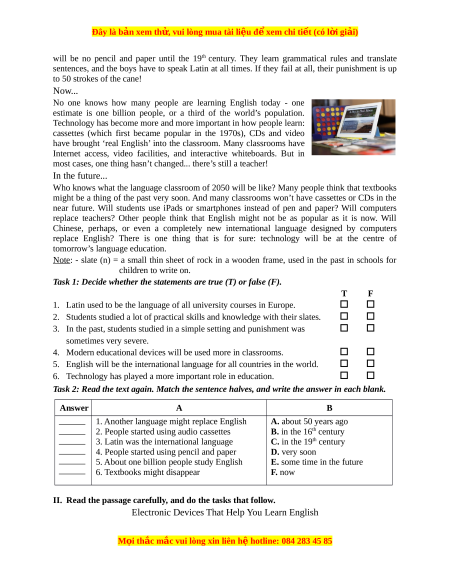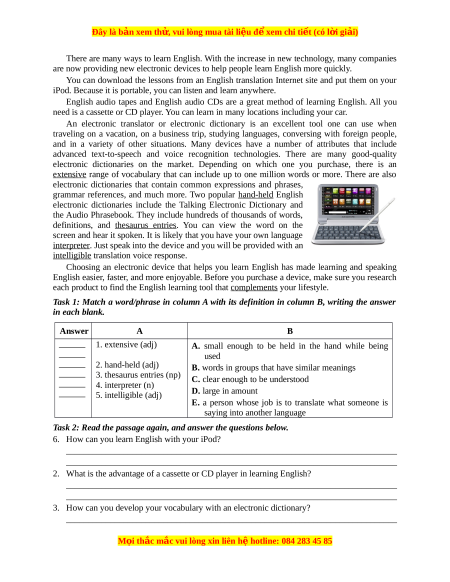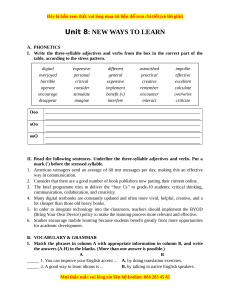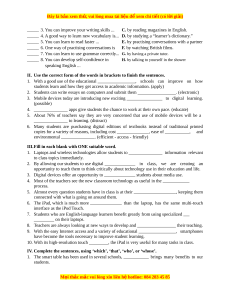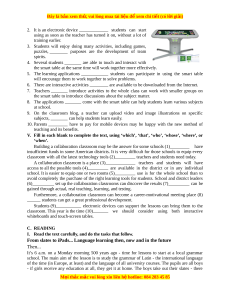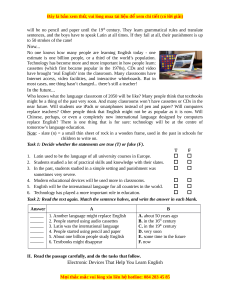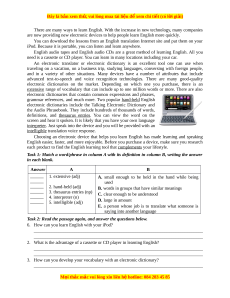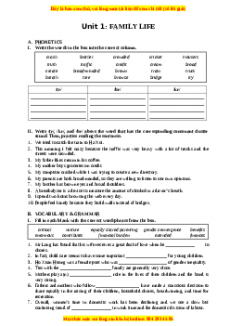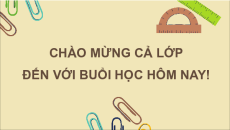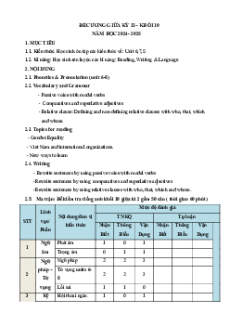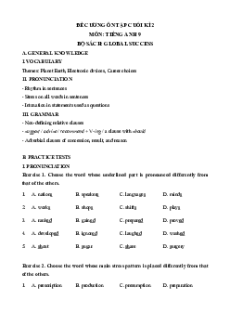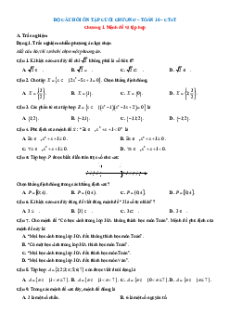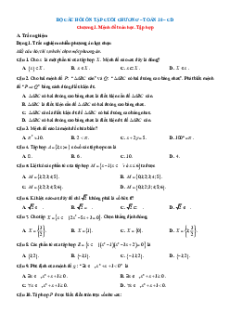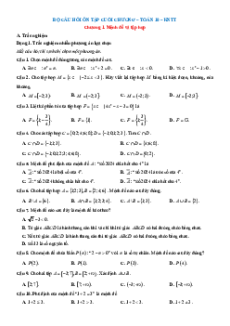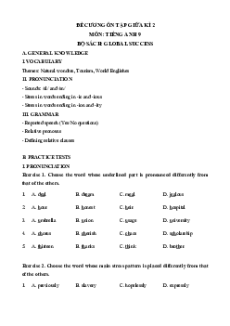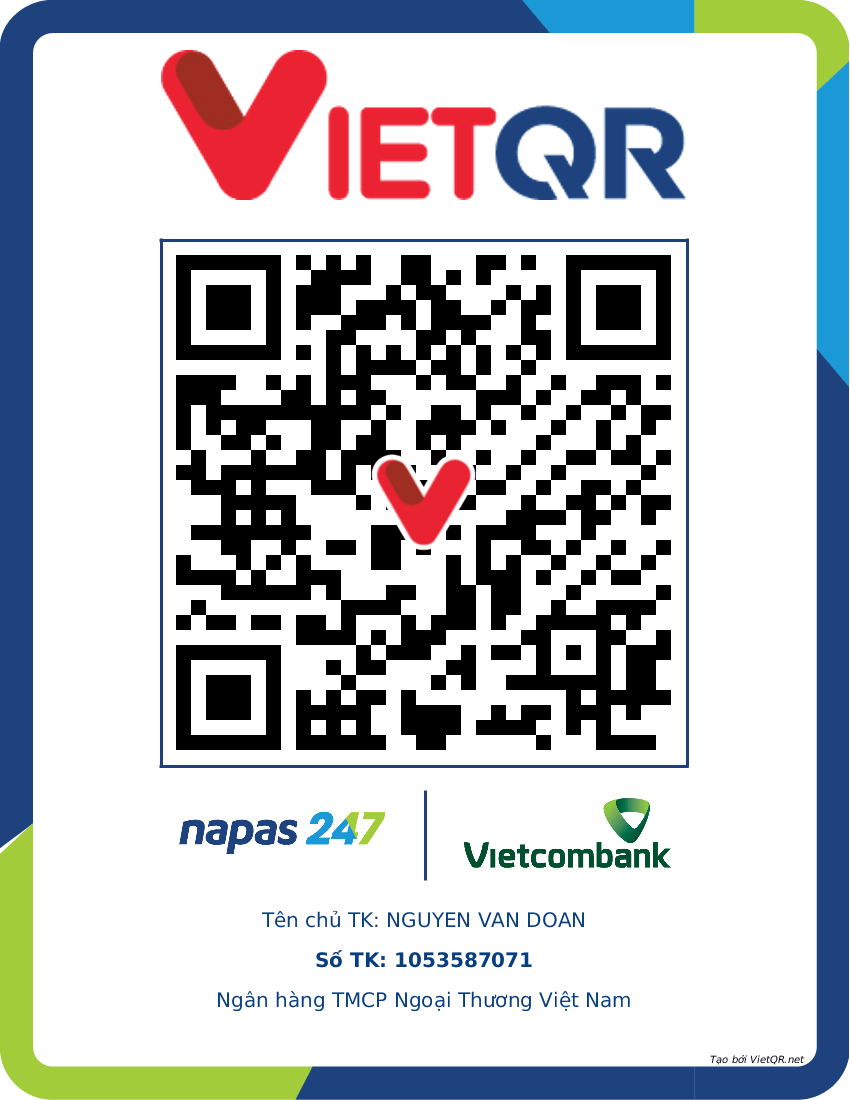Đây là bản xem th , vu ử i lòng mua tài li u ệ đ xe ể m chi ti t ế (có l i ờ gi i ả )
Unit 8: NEW WAYS TO LEARN A. PHONETICS
I. Write the three-syllable adjectives and verbs from the box in the correct part of the
table, according to the stress pattern. digital expensive different astonished impolite overjoyed personal general practical effective horrible critical expensive creative excellent operate consider implement remember calculate encourage stimulate benefit (v) encounter overwrite disappear imagine interfere interact criticize Ooo oOo ooO
II. Read the following sentences. Underline the three-syllable adjectives and verbs. Put a
mark (') before the stressed syllable.
1. American teenagers send an average of 60 text messages per day, making this an effective way in communication.
2. Consider that there are a good number of book publishers now putting their content online.
3. The Intel programme tries to deliver the “four Cs’’ to grade-10 students: critical thinking,
communication, collaboration, and creativity.
4. Many digital textbooks are constantly updated and often more vivid, helpful, creative, and a
lot cheaper than those old heavy books.
5. In order to integrate technology into the classroom, teachers should implement the BYOD
(Bring Your Own Device) policy to make the learning process more relevant and effective.
6. Studies encourage mobile learning because students benefit greatly from more opportunities for academic development. B. VOCABULARY & GRAMMAR
I. Match the phrases in column A with appropriate information in column B, and write
the answers (A-H) in the blanks. (More than one answer is possible.) A B
______ 1. You can improve your English accent ... A. by doing translation exercises.
______ 2. A good way to learn idioms is ...
B. by talking to native English speakers. M i
ọ thắc mắc vui lòng xin liên h h
ệ otline: 084 283 45 85
Đây là bản xem th , vu ử i lòng mua tài li u ệ đ xe ể m chi ti t ế (có l i ờ gi i ả )
______ 3. You can improve your writing skills ...
C. by reading magazines in English.
______ 4. A good way to learn new vocabulary is... D. by studying a “learner’s dictionary.”
______ 5. You can learn to read faster ...
E. by practising conversations with a partner
______ 6. One way of practising conversations is
F. by watching British films.
______ 7. You can learn to use grammar correctly... G. by having a private tutor.
______ 8. You can develop self-confidence in
H. by talking to yourself in the shower speaking English ...
II. Use the correct form of the words in brackets to finish the sentences.
1. With a good use of the educational , schools can improve on how
students learn and how they get access to academic information. (apply)
2. Students can write essays on computers and submit them . (electronic)
3. Mobile devices today are introducing new exciting to digital learning. (possible) 4.
apps give students the chance to work at their own pace. (educate)
5. About 76% of teachers say they are very concerned that use of mobile devices will be a to learning. (distract)
6. Many students are purchasing digital editions of textbooks instead of traditional printed
copies for a variety of reasons, including cost , ease of , and environmental
. (efficient - access - friendly)
III.Fill in each blank with ONE suitable word.
1. Laptops and wireless technologies allow students to information relevant to class topics immediately.
2. By allowing our students to use digital in class, we are creating an
opportunity to teach them to think critically about technology use in their education and life.
3. Digital devices offer an opportunity to students about media use.
4. Most of the teachers see the new classroom technology as useful in the process.
5. Almost every question students have in class is at their , keeping them
connected with what is going on around them.
6. The iPad, which is much more
than the laptop, has the same multi-touch interface as the iPod Touch.
7. Students who are English-language learners benefit greatly from using specialized on their laptops.
8. Teachers are always looking at new ways to develop and their teaching.
9. With the easy Internet access and a variety of educational , smartphones
have become the tools necessary to improve student learning.
10. With its high-resolution touch
, the iPad is very useful for many tasks in class.
IV. Complete the sentences, using ‘which’, ‘that’, ‘who’, or ‘whose’.
1. The smart table has been used in several schools, brings many benefits to our students. M i
ọ thắc mắc vui lòng xin liên h h
ệ otline: 084 283 45 85
Đây là bản xem th , vu ử i lòng mua tài li u ệ đ xe ể m chi ti t ế (có l i ờ gi i ả ) 2. It is an electronic device students can start
using as soon as the teacher has turned it on, without a lot of training earlier.
3. Students will enjoy doing many activities, including games, puzzles,
purposes are the development of team spirits. 4. Several students
are able to touch and interact with
the smart table at the same time will work together more effectively. 5. The learning applications
students can participate in using the smart table
will encourage them to work together to solve problems.
6. There are interactive activities
are available to be downloaded from the Internet. 7. Teachers
introduce activities to the whole class can work with smaller groups on
the smart table to introduce discussions about the subject matter. 8. The applications
come with the smart table can help students learn various subjects at school.
9. On the classroom blog, a teacher can upload video and image illustrations on specific subjects,
can help students learn easily. 10. Parents
have to pay for mobile devices may be happy with the new method of teaching and its benefits.
V. Fill in each blank to complete the text, using ‘which’, ‘that’, ‘who’, ‘whose’, ‘where’, or ‘when’.
Building a collaboration classroom may be the answer for some schools (1) have
insufficient funds in some American districts. It is very difficult for those schools to equip every
classroom with all the latest technology tools (2)
teachers and students need today.
A collaboration classroom is a place (3)
teachers and students will have
access to all the possible tools (4)
are available in the district or in any individual
school. It is easier to equip one or two rooms (5)
use is for the whole school than to
avoid completely the purchase of the right learning tools for students. School and district leaders (6)
set up the collaboration classrooms can discover the results (7) can be
gained through actual, real teaching, learning, and testing.
Furthermore, a collaboration classroom can become a career-motivational meeting place (8)
students can get a great professional development. Students (9)
electronic devices can support the lessons can bring them to the
classroom. This year is the time (10)
we should consider using both interactive
whiteboards and touch-screen tables. C. READING
I. Read the text carefully, and do the tasks that follow.
From slates to iPads... Language learning then, now and in the future Then...
It’s 6 a.m. on a Monday morning 500 years ago - time for lessons to start at a local grammar
school. The main aim of the lesson is to study the grammar of Latin - the international language
of the time (in Europe, at least) and the language of all university courses. The pupils are all boys
- if girls receive any education at all, they get it at home. The boys take out their slates - there M i
ọ thắc mắc vui lòng xin liên h h
ệ otline: 084 283 45 85
Đây là bản xem th , vu ử i lòng mua tài li u ệ đ xe ể m chi ti t ế (có l i ờ gi i ả )
will be no pencil and paper until the 19th century. They learn grammatical rules and translate
sentences, and the boys have to speak Latin at all times. If they fail at all, their punishment is up to 50 strokes of the cane! Now...
No one knows how many people are learning English today - one
estimate is one billion people, or a third of the world’s population.
Technology has become more and more important in how people learn:
cassettes (which first became popular in the 1970s), CDs and video
have brought ‘real English’ into the classroom. Many classrooms have
Internet access, video facilities, and interactive whiteboards. But in
most cases, one thing hasn’t changed... there’s still a teacher! In the future...
Who knows what the language classroom of 2050 will be like? Many people think that textbooks
might be a thing of the past very soon. And many classrooms won’t have cassettes or CDs in the
near future. Will students use iPads or smartphones instead of pen and paper? Will computers
replace teachers? Other people think that English might not be as popular as it is now. Will
Chinese, perhaps, or even a completely new international language designed by computers
replace English? There is one thing that is for sure: technology will be at the centre of
tomorrow’s language education.
Note: - slate (n) = a small thin sheet of rock in a wooden frame, used in the past in schools for children to write on.
Task 1: Decide whether the statements are true (T) or false (F). T F
1. Latin used to be the language of all university courses in Europe.
2. Students studied a lot of practical skills and knowledge with their slates.
3. In the past, students studied in a simple setting and punishment was sometimes very severe.
4. Modern educational devices will be used more in classrooms.
5. English will be the international language for all countries in the world.
6. Technology has played a more important role in education.
Task 2: Read the text again. Match the sentence halves, and write the answer in each blank. Answer A B
1. Another language might replace English A. about 50 years ago
2. People started using audio cassettes B. in the 16th century
3. Latin was the international language C. in the 19th century
4. People started using pencil and paper D. very soon
5. About one billion people study English
E. some time in the future 6. Textbooks might disappear F. now
II. Read the passage carefully, and do the tasks that follow.
Electronic Devices That Help You Learn English M i
ọ thắc mắc vui lòng xin liên h h
ệ otline: 084 283 45 85
Bài tập Unit 8: New ways to learn Tiếng Anh 10 chương trình thí điểm
1 K
494 lượt tải
MUA NGAY ĐỂ XEM TOÀN BỘ TÀI LIỆU
CÁCH MUA:
- B1: Gửi phí vào TK:
1133836868- CT TNHH DAU TU VA DV GD VIETJACK - Ngân hàng MB (QR) - B2: Nhắn tin tới Zalo VietJack Official ( nhấn vào đây ) để xác nhận thanh toán và tải tài liệu - giáo án
Liên hệ ngay Hotline hỗ trợ: 084 283 45 85
Tài liệu được cập nhật liên tục trong gói này từ nay đến hết tháng 6/2023. Chúng tôi đảm bảo đủ số lượng đề đã cam kết hoặc có thể nhiều hơn, tất cả có BẢN WORD, LỜI GIẢI CHI TIẾT và tải về dễ dàng.
Để tải tài liệu gốc về máy bạn click vào nút Tải Xuống ở trên!
Thuộc bộ (mua theo bộ để tiết kiệm hơn):
- Tailieugiaovien.com.vn giới thiệu Bộ bài tập trắc nghiệm Tiếng Anh lớp 10 chương trình thí điểm mới nhất năm 2022 - 2023 nhằm giúp Giáo viên có thêm tài liệu tham khảo bài tập Tiếng Anh lớp 10.
- File word có lời giải chi tiết 100%.
- Mua trọn bộ sẽ tiết kiệm hơn tải lẻ 50%.
Đánh giá
4.6 / 5(987 )5
4
3
2
1
Trọng Bình
Tài liệu hay
Giúp ích cho tôi rất nhiều
Duy Trần
Tài liệu chuẩn
Rất thích tài liệu bên VJ soạn (bám sát chương trình dạy)
TÀI LIỆU BỘ BÁN CHẠY MÔN Tiếng Anh
Xem thêmTÀI LIỆU BỘ BÁN CHẠY Lớp 10
Xem thêmTài liệu bộ mới nhất

Đây là b n xem th , vui lòng mua tài li u đ xem chi ti t (có l i gi i)ả ử ệ ể ế ờ ả
Unit 8: NEW WAYS TO LEARN
A. PHONETICS
I. Write the three-syllable adjectives and verbs from the box in the correct part of the
table, according to the stress pattern.
II. Read the following sentences. Underline the three-syllable adjectives and verbs. Put a
mark (') before the stressed syllable.
1. American teenagers send an average of 60 text messages per day, making this an effective
way in communication.
2. Consider that there are a good number of book publishers now putting their content online.
3. The Intel programme tries to deliver the “four Cs’’ to grade-10 students: critical thinking,
communication, collaboration, and creativity.
4. Many digital textbooks are constantly updated and often more vivid, helpful, creative, and a
lot cheaper than those old heavy books.
5. In order to integrate technology into the classroom, teachers should implement the BYOD
(Bring Your Own Device) policy to make the learning process more relevant and effective.
6. Studies encourage mobile learning because students benefit greatly from more opportunities
for academic development.
B. VOCABULARY & GRAMMAR
I. Match the phrases in column A with appropriate information in column B, and write
the answers (A-H) in the blanks. (More than one answer is possible.)
A B
______ 1. You can improve your English accent ... A. by doing translation exercises.
______ 2. A good way to learn idioms is ... B. by talking to native English speakers.
M i th c m c vui lòng xin liên h hotline: 084 283 45 85ọ ắ ắ ệ
digital expensive different astonished impolite
overjoyed personal general practical effective
horrible critical expensive creative excellent
operate consider implement remember calculate
encourage stimulate benefit (v) encounter overwrite
disappear imagine interfere interact criticize
Ooo
oOo
ooO

Đây là b n xem th , vui lòng mua tài li u đ xem chi ti t (có l i gi i)ả ử ệ ể ế ờ ả
______ 3. You can improve your writing skills ... C. by reading magazines in English.
______ 4. A good way to learn new vocabulary is... D. by studying a “learner’s dictionary.”
______ 5. You can learn to read faster ... E. by practising conversations with a partner
______ 6. One way of practising conversations is F. by watching British films.
______ 7. You can learn to use grammar correctly... G. by having a private tutor.
______ 8. You can develop self-confidence in H. by talking to yourself in the shower
speaking English ...
II. Use the correct form of the words in brackets to finish the sentences.
1. With a good use of the educational , schools can improve on how
students learn and how they get access to academic information. (apply)
2. Students can write essays on computers and submit them . (electronic)
3. Mobile devices today are introducing new exciting to digital learning.
(possible)
4. apps give students the chance to work at their own pace. (educate)
5. About 76% of teachers say they are very concerned that use of mobile devices will be a
to learning. (distract)
6. Many students are purchasing digital editions of textbooks instead of traditional printed
copies for a variety of reasons, including cost , ease of , and
environmental . (efficient - access - friendly)
III.Fill in each blank with ONE suitable word.
1. Laptops and wireless technologies allow students to information relevant
to class topics immediately.
2. By allowing our students to use digital in class, we are creating an
opportunity to teach them to think critically about technology use in their education and life.
3. Digital devices offer an opportunity to students about media use.
4. Most of the teachers see the new classroom technology as useful in the
process.
5. Almost every question students have in class is at their , keeping them
connected with what is going on around them.
6. The iPad, which is much more than the laptop, has the same multi-touch
interface as the iPod Touch.
7. Students who are English-language learners benefit greatly from using specialized
on their laptops.
8. Teachers are always looking at new ways to develop and their teaching.
9. With the easy Internet access and a variety of educational , smartphones
have become the tools necessary to improve student learning.
10. With its high-resolution touch , the iPad is very useful for many tasks in class.
IV. Complete the sentences, using ‘which’, ‘that’, ‘who’, or ‘whose’.
1. The smart table has been used in several schools, brings many benefits to our
students.
M i th c m c vui lòng xin liên h hotline: 084 283 45 85ọ ắ ắ ệ

Đây là b n xem th , vui lòng mua tài li u đ xem chi ti t (có l i gi i)ả ử ệ ể ế ờ ả
2. It is an electronic device students can start
using as soon as the teacher has turned it on, without a lot of
training earlier.
3. Students will enjoy doing many activities, including games,
puzzles, purposes are the development of team
spirits.
4. Several students are able to touch and interact with
the smart table at the same time will work together more effectively.
5. The learning applications students can participate in using the smart table
will encourage them to work together to solve problems.
6. There are interactive activities are available to be downloaded from the Internet.
7. Teachers introduce activities to the whole class can work with smaller groups on
the smart table to introduce discussions about the subject matter.
8. The applications come with the smart table can help students learn various subjects
at school.
9. On the classroom blog, a teacher can upload video and image illustrations on specific
subjects, can help students learn easily.
10. Parents have to pay for mobile devices may be happy with the new method of
teaching and its benefits.
V. Fill in each blank to complete the text, using ‘which’, ‘that’, ‘who’, ‘whose’, ‘where’, or
‘when’.
Building a collaboration classroom may be the answer for some schools (1) have
insufficient funds in some American districts. It is very difficult for those schools to equip every
classroom with all the latest technology tools (2) teachers and students need today.
A collaboration classroom is a place (3) teachers and students will have
access to all the possible tools (4) are available in the district or in any individual
school. It is easier to equip one or two rooms (5) use is for the whole school than to
avoid completely the purchase of the right learning tools for students. School and district leaders
(6) set up the collaboration classrooms can discover the results (7) can be
gained through actual, real teaching, learning, and testing.
Furthermore, a collaboration classroom can become a career-motivational meeting place (8)
students can get a great professional development.
Students (9) electronic devices can support the lessons can bring them to the
classroom. This year is the time (10) we should consider using both interactive
whiteboards and touch-screen tables.
C. READING
I. Read the text carefully, and do the tasks that follow.
From slates to iPads... Language learning then, now and in the future
Then...
It’s 6 a.m. on a Monday morning 500 years ago - time for lessons to start at a local grammar
school. The main aim of the lesson is to study the grammar of Latin - the international language
of the time (in Europe, at least) and the language of all university courses. The pupils are all boys
- if girls receive any education at all, they get it at home. The boys take out their slates - there
M i th c m c vui lòng xin liên h hotline: 084 283 45 85ọ ắ ắ ệ

Đây là b n xem th , vui lòng mua tài li u đ xem chi ti t (có l i gi i)ả ử ệ ể ế ờ ả
will be no pencil and paper until the 19
th
century. They learn grammatical rules and translate
sentences, and the boys have to speak Latin at all times. If they fail at all, their punishment is up
to 50 strokes of the cane!
Now...
No one knows how many people are learning English today - one
estimate is one billion people, or a third of the world’s population.
Technology has become more and more important in how people learn:
cassettes (which first became popular in the 1970s), CDs and video
have brought ‘real English’ into the classroom. Many classrooms have
Internet access, video facilities, and interactive whiteboards. But in
most cases, one thing hasn’t changed... there’s still a teacher!
In the future...
Who knows what the language classroom of 2050 will be like? Many people think that textbooks
might be a thing of the past very soon. And many classrooms won’t have cassettes or CDs in the
near future. Will students use iPads or smartphones instead of pen and paper? Will computers
replace teachers? Other people think that English might not be as popular as it is now. Will
Chinese, perhaps, or even a completely new international language designed by computers
replace English? There is one thing that is for sure: technology will be at the centre of
tomorrow’s language education.
Note: - slate (n) = a small thin sheet of rock in a wooden frame, used in the past in schools for
children to write on.
Task 1: Decide whether the statements are true (T) or false (F).
T F
1. Latin used to be the language of all university courses in Europe.
2. Students studied a lot of practical skills and knowledge with their slates.
3. In the past, students studied in a simple setting and punishment was
sometimes very severe.
4. Modern educational devices will be used more in classrooms.
5. English will be the international language for all countries in the world.
6. Technology has played a more important role in education.
Task 2: Read the text again. Match the sentence halves, and write the answer in each blank.
II. Read the passage carefully, and do the tasks that follow.
Electronic Devices That Help You Learn English
M i th c m c vui lòng xin liên h hotline: 084 283 45 85ọ ắ ắ ệ
Answer A B
1. Another language might replace English
2. People started using audio cassettes
3. Latin was the international language
4. People started using pencil and paper
5. About one billion people study English
6. Textbooks might disappear
A. about 50 years ago
B. in the 16
th
century
C. in the 19
th
century
D. very soon
E. some time in the future
F. now

Đây là b n xem th , vui lòng mua tài li u đ xem chi ti t (có l i gi i)ả ử ệ ể ế ờ ả
There are many ways to learn English. With the increase in new technology, many companies
are now providing new electronic devices to help people learn English more quickly.
You can download the lessons from an English translation Internet site and put them on your
iPod. Because it is portable, you can listen and learn anywhere.
English audio tapes and English audio CDs are a great method of learning English. All you
need is a cassette or CD player. You can learn in many locations including your car.
An electronic translator or electronic dictionary is an excellent tool one can use when
traveling on a vacation, on a business trip, studying languages, conversing with foreign people,
and in a variety of other situations. Many devices have a number of attributes that include
advanced text-to-speech and voice recognition technologies. There are many good-quality
electronic dictionaries on the market. Depending on which one you purchase, there is an
extensive range of vocabulary that can include up to one million words or more. There are also
electronic dictionaries that contain common expressions and phrases,
grammar references, and much more. Two popular hand-held English
electronic dictionaries include the Talking Electronic Dictionary and
the Audio Phrasebook. They include hundreds of thousands of words,
definitions, and thesaurus entries. You can view the word on the
screen and hear it spoken. It is likely that you have your own language
interpreter. Just speak into the device and you will be provided with an
intelligible translation voice response.
Choosing an electronic device that helps you learn English has made learning and speaking
English easier, faster, and more enjoyable. Before you purchase a device, make sure you research
each product to find the English learning tool that complements your lifestyle.
Task 1: Match a word/phrase in column A with its definition in column B, writing the answer
in each blank.
Task 2: Read the passage again, and answer the questions below.
6. How can you learn English with your iPod?
___________________________________________________________________________
___________________________________________________________________________
2. What is the advantage of a cassette or CD player in learning English?
___________________________________________________________________________
___________________________________________________________________________
3. How can you develop your vocabulary with an electronic dictionary?
___________________________________________________________________________
M i th c m c vui lòng xin liên h hotline: 084 283 45 85ọ ắ ắ ệ
Answer A B
1. extensive (adj)
2. hand-held (adj)
3. thesaurus entries (np)
4. interpreter (n)
5. intelligible (adj)
A. small enough to be held in the hand while being
used
B. words in groups that have similar meanings
C. clear enough to be understood
D. large in amount
E. a person whose job is to translate what someone is
saying into another language
